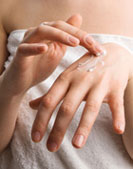| |
Eczema
Eczema, also known as atopic dermatitis is a group of inflammatory skin conditions that result in chronic itchy rashes. About 15 million people in the U.S. suffer from some form of eczema, including 10 to 20 percent of all infants. Symptoms vary and often include dry, red, itchy patches on the skin which break out in rashes when irritated by scratch. Eczema is often seen in children who have a family or personal history of asthma or seasonal allergies.
 Objects and conditions that trigger eczema outbreaks may include rough or coarse materials touching the skin, excessive heat or sweating, perfumed soaps, lotions, or detergents. Some people react to various foods, dust mites, animal dander, upper respiratory infections and stress. Objects and conditions that trigger eczema outbreaks may include rough or coarse materials touching the skin, excessive heat or sweating, perfumed soaps, lotions, or detergents. Some people react to various foods, dust mites, animal dander, upper respiratory infections and stress.
Treatment can include prescription creams including antibiotics to combat infection, corticosteroid medication, immune-modulators, or sedative antihistamines. Once skin clearance is achieved, maintenance includes restriction of scratching, use of moisturizing lotions or creams, and over the counter anti-inflammatory corticosteroid creams and ointments.
Birthmarks and Moles
Moles and other birthmarks are pigmented spots or patches of skin that range in color from tan, brown and black (moles) to red, pink or purple (vascular nevi, such as strawberry hemangiomas or port wine stains). Some birthmarks appear shortly after birth, and others appear in childhood. Though most birthmarks are harmless, there are some that can be abnormal and it is important to have your child’s skin examined to make sure all moles are benign. Another advantage to having a skin check is that there can be an ongoing record of any change that may develop. Depending on their depth, location and color, as well as the patient's skin type, age and other factors, treatment for benign birthmarks is available.
Cradle Cap (Seborrheic Dermatitis)
 Cradle cap is simply dandruff of the scalp. It can look like flakes or a thick yellow crust. It occurs frequently in newborns, and may be due to the effects of circulating hormones from mom. It may not look pretty, but it is completely harmless, and usually resolves with in the first 12 months. Seborrheic dermatitis of the scalp in babies is treated with products that are not as strong as those used in adults. Gently brushing your baby’s scalp with a soft brush and using a non-medicated baby shampoo is a good start and can help loosen scales or flakes. If that doesn't work, your baby may need a special medicated shampoo specially formulated for babies, and a mild topical cream. Cradle cap is simply dandruff of the scalp. It can look like flakes or a thick yellow crust. It occurs frequently in newborns, and may be due to the effects of circulating hormones from mom. It may not look pretty, but it is completely harmless, and usually resolves with in the first 12 months. Seborrheic dermatitis of the scalp in babies is treated with products that are not as strong as those used in adults. Gently brushing your baby’s scalp with a soft brush and using a non-medicated baby shampoo is a good start and can help loosen scales or flakes. If that doesn't work, your baby may need a special medicated shampoo specially formulated for babies, and a mild topical cream.
Warts
Common warts, not to be confused with genital warts, are caused by the Human Papilloma Virus and may spread by contact with infected skin. Warts usually present as flesh-colored, raised, rough bumps that may have black dots. Since it is caused by a virus which has no cure, therapies are mainly destructive and aim to destroy skin cells which harbor the virus. Treatments include liquid nitrogen (freezing), topical applications of salicylic acid or cantharidin, electrosurgery, and immunotherapy. Often times, a series of treatments 4 weeks apart will need to be scheduled until complete clearance is achieved.
Diaper Dermatitis
Most kids have diaper rash at some point in their early lives. For most it is a nuisance, but for others it can be a serious problem that persists. Often times this rash may be a sign of an underlying infection that will need prescription medication to resolve. Once treated, there are certain steps that can be taken to ensure that the rash does not recur. Dr. Berke has a variety of treatment plans that will improve even the most persistent cases of diaper dermatitis.
Baby acne
Baby acne can be quite common in the first few months and may persist until 6 months. Some common causes are maternal hormones, irritated skin from saliva or detergents, and heat. Depending on the cause and distribution there are various topical remedies to help keep this condition under control.
Teenage Acne
Acne can affect all ages starting from the newborn, to teenagers and even adults. Acne can be the source of great emotional stress and may lead to emotional and physical scarring if not treated promptly and appropriately. The good news is nobody has to have acne because so many treatment options are available. Over the counter preparations can be helpful, but if clearance is not achieved within several weeks, prescription medication may be required.
For those patients who already have acne scarring, treatment may include certain skin care products, chemical peels, soft tissue fillers, and dermabrasion.
|
|